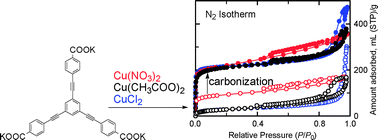1,3,5-Tris(functionalised-phenylethynyl)benzene–metal complexes: synthetic survey of mesoporous coordination polymers and investigation of their carbonisation†
Abstract
A series of multicoordinate 1,3,5-tris(functionalised-phenylethynyl)benzenes (1–9) was synthesised, and coordination polymers were constructed from these organic linkers and copper ions in high yields. The carbonisation of the linkers 1–9 afforded a microporous carbon that shows type I adsorption–desorption isotherm. Although most of the coordination polymers prepared in this study turned out to be low porous materials, the coordination polymer 7e prepared from the reaction of 1,3,5-tris(4-carboxyphenylethynyl)benzene tripotassium salt (K37) and copper(II)


 Please wait while we load your content...
Please wait while we load your content...